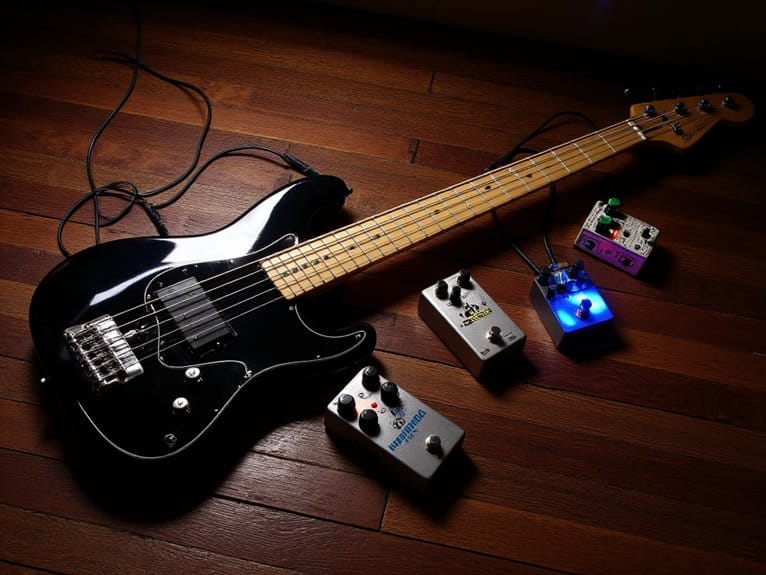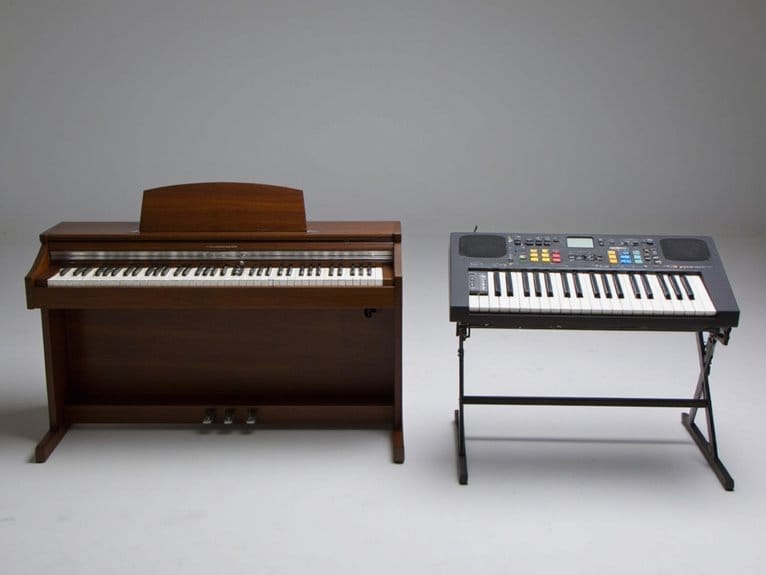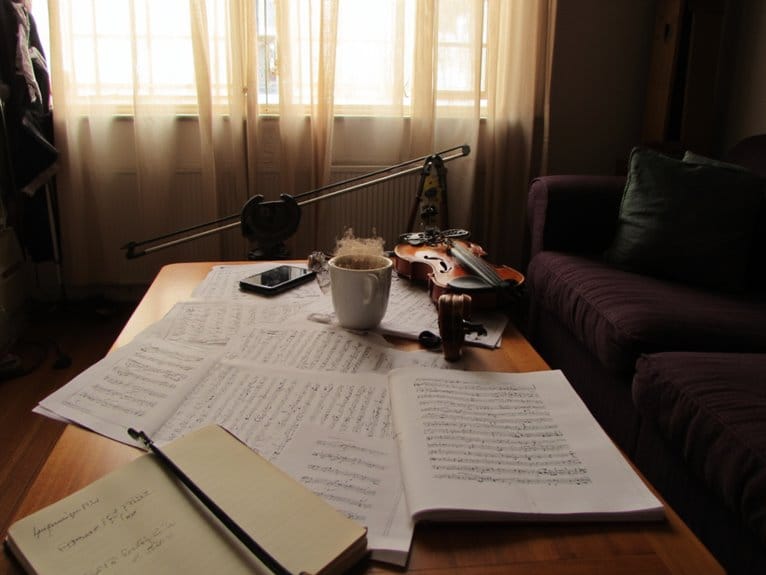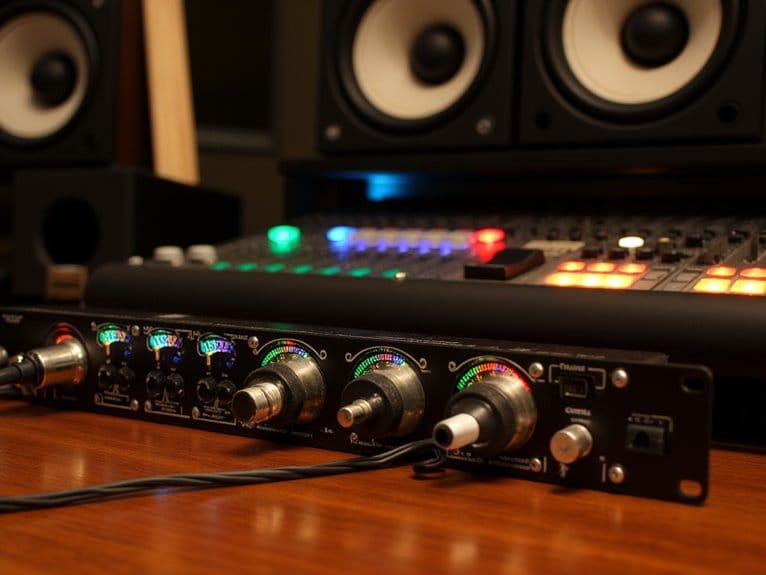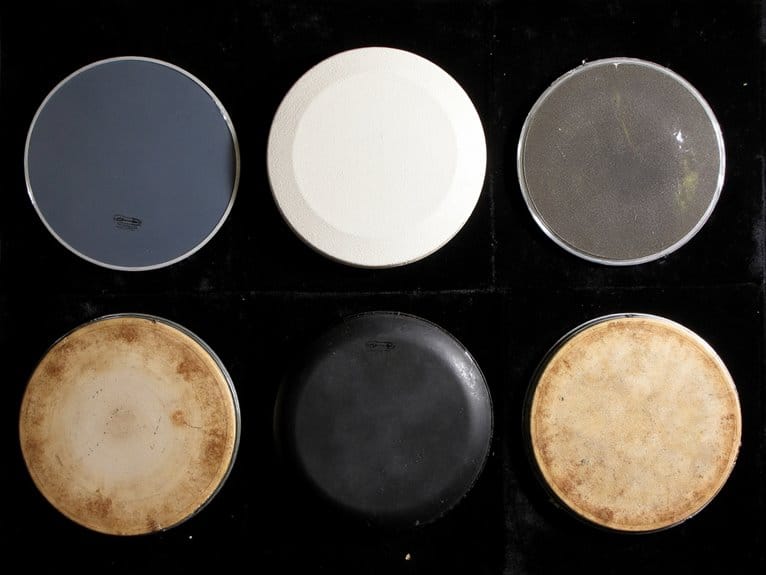Bass Guitar Effects: Which Ones Work Best for Bass
You’ll want to prioritize compressor pedals for consistent volume control across slapping and fingerstyle techniques, while chromatic tuner pedals guarantee precise pitch accuracy during performances. Bass-specific overdrive units like the Darkglass ADAM maintain low-end clarity through blend controls that balance clean and saturated signals. Modulation effects including chorus, envelope filters, and octave pedals add dimension without compromising fundamental frequencies, while short delays and subtle reverb enhance spatial depth. Multi-effects pedals offer thorough tone shaping with bass-optimized processing that preserves frequencies below 80Hz, and expression pedal integration provides real-time parameter adjustments for dynamic live performance control that transforms your sound.
We are supported by our audience. When you purchase through links on our site, we may earn an affiliate commission, at no extra cost for you. Learn more.
Notable Insights
- Compressor and tuner pedals are essential foundations, providing consistent volume control and pitch accuracy for professional bass performance.
- Bass-specific overdrive pedals like Darkglass ADAM maintain low-end clarity while adding saturation through proper gain staging and blend controls.
- Multi-effects units offer versatile tone shaping with numerous amp models and effects, providing cost-effective solutions for diverse musical styles.
- Modulation effects like chorus, flanger, and envelope filters add dimension and movement without compromising the bass’s fundamental frequencies.
- Preamp modeling delivers vintage tube warmth or modern hi-fi precision while maintaining tight, defined frequencies below 80Hz.
Compressor Pedals: Essential Dynamic Control for Bass Players
Most bass players discover that achieving consistent volume and tone across different playing techniques remains one of their biggest challenges, whether they’re laying down a steady groove or exploring more dynamic musical passages.
Compressor pedals solve this problem by controlling your dynamic range, making loud notes softer while bringing up quieter sounds, ensuring you maintain a consistent presence in the mix without losing your natural playing feel.
A compressor pedal tames your dynamic range, smoothing out volume spikes while preserving your natural playing dynamics and musical expression.
These pedals offer essential compression techniques through key controls like threshold, ratio, attack, and release settings, giving you precise dynamic control over your sound.
Whether you’re slapping, picking, or playing fingerstyle, a quality compressor helps even out volume inconsistencies across all strings and frets, adding sustain and that professional “fat” tone that keeps your bass lines audible in any band setting. Compressors are particularly essential for gigging bassists who perform in varied venues, helping to reduce unwanted boomy sounds from low-quality PA systems while amplifying your tone in ampless setups.
For optimal results, position your compressor pedal at the beginning of your signal chain to ensure clean input and prevent amplifying unwanted noise from other effects.
Tuner Pedals: Maintaining Perfect Pitch and Intonation
While compression shapes your dynamic response, staying in tune forms the foundation that makes every other effect worthwhile.
I’ve learned that even the most expensive bass setup sounds amateur when pitch drifts during performance.
Modern tuner pedals offer chromatic modes for precise string-by-string adjustment, while polyphonic features like TC Electronic’s PolyTune 3 let you check all strings simultaneously for faster stage changes.
Professional-grade units provide strobe tuning accuracy that I honestly can’t distinguish from perfect pitch, though my ears appreciate the precision during recording sessions.
Essential pedal features include bright LED displays for stage visibility, true bypass options to preserve your tone, and calibration settings for different ensemble standards, ensuring your bass stays locked in regardless of lighting conditions or performance environment. Many tuners connect seamlessly through USB-C connectivity for firmware updates and power options when used in studio environments. Some models incorporate buffered bypass circuitry that maintains signal integrity over long cable runs, though this can slightly alter your tone compared to true bypass designs. Quality oxygen-free copper conductors in your cables connecting the tuner pedal help ensure the cleanest possible signal transmission to maintain tuning accuracy. For players dealing with noisy venues, vibration-sensing clip-on tuners provide an alternative that bypasses ambient sound interference entirely.
Overdrive and Distortion: Adding Grit Without Losing Low-End Clarity
Adding grit to your bass tone without sacrificing the fundamental low-end that anchors your band’s sound requires understanding the essential difference between overdrive and distortion. I’ve found that choosing the wrong approach can leave you sounding thin and lost in the mix.
Overdrive characteristics include soft clipping that preserves low-end clarity while adding warm, tube-amp-like saturation, whereas distortion techniques involve aggressive clipping that creates heavier saturation but can thin your frequencies.
I recommend bass-specific pedals like the Darkglass ADAM or MXR M85, which feature dedicated bass controls and EQ sections. Using moderate gain settings prevents excessive clipping that robs your fundamental frequencies, while pedals with blend controls let you balance clean signal with affected tone for peak clarity. True bypass switching ensures your clean tone maintains its integrity when the pedal is disengaged.
The MXR Bass D.I.+ offers a dual-channel approach that combines tone shaping capabilities with a noise gate to minimize unwanted background interference while maintaining your low-end foundation. For bassists seeking maximum versatility, multi-effects pedals like the Boss GT-1B provide 90 effects with premium sound engines that can deliver both overdrive and distortion alongside comprehensive tone-shaping tools.
Modulation Effects: Creating Movement and Texture in Your Bass Sound
When you’re looking to add dimension and movement to your bass playing, modulation effects offer a sophisticated palette of tools that can transform static low-end into something that breathes, swirls, and captivates listeners without sacrificing your instrument’s fundamental role in the mix.
Chorus usage excels at creating shimmer and thickness, particularly effective for fretless players seeking harmonic enhancement. Flanger techniques produce dramatic swooping sounds through variable delay times, while phaser effects deliver subtler psychedelic movement through frequency cancellations.
Envelope filter responds dynamically to your playing intensity, creating expressive auto-wah effects popular in funk styles. Octave pedals expand your tonal range by generating harmonic intervals, and synth modulation transforms your bass into atmospheric textures, perfect for experimental genres.
Delay and Reverb: Spatial Effects That Enhance Rather Than Overwhelm
Although modulation effects can transform your bass into a swirling sonic landscape, delay and reverb represent the subtle art of spatial enhancement, where the goal isn’t to announce their presence but to create an invisible foundation that makes your instrument feel naturally positioned within a three-dimensional soundscape.
I’ve learned that delayed echoes work best with short repeat times, typically under 200ms, maintaining groove clarity while adding rhythmic complexity. Tape delay emulations provide those warm, vintage textures that complement dub-style playing perfectly.
| Effect Type | Best Application |
|---|---|
| Short Delay (50-150ms) | Groove enhancement without clutter |
| Tape Delay | Vintage, textured ambient textures |
| Plate Reverb | Subtle spatial depth for solo bass |
The key lies in restraint—use wet/dry blending to preserve your fundamental tone while adding just enough spatial character to make your bass breathe naturally within any mix.
Multi-Effects and Preamp Pedals: Comprehensive Tone Shaping Solutions
While individual effects pedals excel at specific tasks, I’ve discovered that multi-effects units represent the Swiss Army knife approach to bass tone shaping, combining compression, overdrive, modulation, spatial effects, and importantly, thorough preamp modeling into streamlined packages that can transform your fundamental sound from vintage tube warmth to modern hi-fi precision.
These units offer remarkable multifunctionality features, with models like the Boss GX-100 providing 23 amp types and over 150 effects, while the tc Electronic Plethora X5 delivers 127 presets for extensive sound tailoring.
What I appreciate most is their bass-optimized processing, ensuring frequencies below 80Hz remain tight and defined, plus expression pedal integration for real-time parameter control during performances.
Frequently Asked Questions
Should I Use a Power Supply or Batteries for My Bass Effects Pedals?
You should choose power supplies for their stability and multiple pedal support benefits, while batteries offer portability but suffer from poor battery longevity and frequent replacements during extended playing sessions.
How Do I Prevent Noise and Hum When Chaining Multiple Bass Effects Together?
You’ll prevent noise by using isolated power supplies, proper shielding techniques like quality cables, strategic pedal placement with gates after distortion, true bypass loops, and avoiding daisy-chaining digital with analog effects.
What’s the Ideal Signal Chain Order When Using Several Bass Effects Simultaneously?
Your ideal signal chain follows this pedal order: tuner first, then compressor, wah/filter, octave, overdrive/distortion, noise gate, EQ, modulation effects, volume, delay, and reverb last before your amplifier.
Do I Need Bass-Specific Effects or Can I Use Regular Guitar Pedals?
You can use guitar pedals, but bass pedal compatibility varies by effect type. Bass-specific pedals offer better effects tone shaping for low frequencies, preserving clarity and punch that guitar pedals might filter out.
On a final note
You’ve got the essentials now: compressors for tight dynamics, tuners for precision, overdrive that preserves your low-end punch, modulation effects that add movement without muddying your tone, and spatial effects used sparingly. I’ve found that starting with these fundamentals, rather than diving into elaborate multi-effects immediately, builds better technique and ear training. Your bass deserves effects that complement its natural voice, not mask it entirely.

